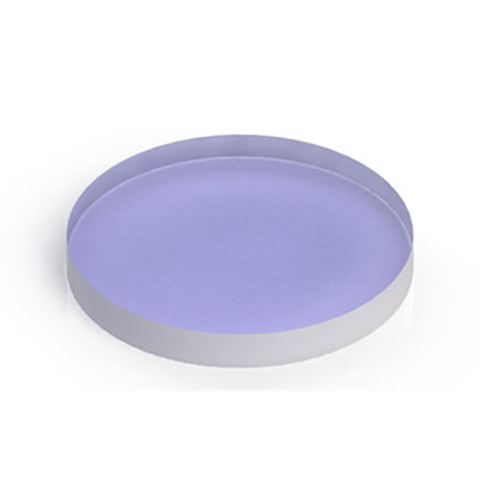Depolarizing
Cube Beamsplitters
Beamsplitters are often classified according to their construction: cube or plate. Cube beamsplitters are essentially composed of two right angle prisms cemented together at the hypotenuse with a partially reflective coating in between. The hypotenuse surface of one prism is coated, and the two prisms are cemented together so that they form a cubic shape. To avoid damaging the cement, it is recommended that the light be transmitted into the coated prism, which often features a reference mark on the ground surface.
Advantages of cube beamsplitters include easy mounting, durability of the optical coating since it is between the two surfaces, and no ghost images since the reflections propagate back in the direction of the source. Disadvantages of cube are that it is bulkier & heavier than other types of beamsplitters and doesn’t cover as wide a wavelength range as pellicle or polka dot beamsplitters. Though we do offer many different coating options. Also cube beamsplitters should only be used with collimated beams since converging or diverging beams contribute to considerable image quality degradation.
Paralight Optics offers cube beamsplitters available both polarizing and non-polarizing models. Non-polarizing beamsplitters are specifically controlled not to alter the S and P polarization states of the incoming light, however with non-polarizing beamsplitters, given the randomly polarized input light, there will still be some polarization effects. Our depolarizing beamsplitters will be not so sensitive to polarization of the incident beam, the difference in reflection and transmission for S- and P-pol is less than 6%, or there isn’t even any difference in in reflection and transmission for S- and P-pol at the certain design wavelengths. Please check the following graphs for your references.

Features:
Substrate Material:
RoHS Compliant
Coating Option:
Hybrid coating, Absorption < 10%
Split Ratio:
Not Sensitive to Polarization of the Incident Beam
Design Options:
Custom Design Available

Common Specifications:

Reference Drawing for
Depolarizing Cube Beamsplitter
Each cube is fabricated from N-BK7 and designed for minimal beam offset. A single reflecting surface also avoids ghost images. The hydrid depolarizing beamsplitter coating is applied to the hypotenuse of one of the two prisms that make up the cube. Then, cement is used to bind the two prism halves together.
Parameters
Ranges & Tolerances
-
Type
Depolarizing cube beamsplitter
-
Dimension Tolerance
+0.00/-0.20 mm
-
Surface Quality (Scratch-Dig)
60-40
-
Surface Flatness (Plano Side)
< λ/4 @632.8 nm per 25mm
-
Transmitted Wavefront Error
< λ/4 @632.8 nm over clear aperture
-
Beam Deviation
Transmitted: 0° ± 3 arcmin | Reflected: 90° ± 3 arcmin
-
Chamfer
Protected < 0.5mm X 45°
-
Split Ratio (R:T) Tolerance
± 5%
-
Overall Performance
Tabs = 45 ± 5%, Tabs + Rabs > 90%, |Ts - Tp| < 6% and |Rs - Rp| < 6%
-
Clear Aperture
> 90%
-
Coating
Hydrid depolarizing beamsplitter coating on hypotenuse surface, AR coating on all entrances
-
Damage Threshold
>100mJ/cm2, 20ns, 20Hz, @1064nm

Graphs
These graphs show that for our 45:45 ± 5% depolarizing cube beamsplitters there is little differences in transmission for S- and P-pol at the design wavelength ranges. For more information on other split ratios such as 10:90, 30-70, 50:50, 70:30, 90:10 or get a quote, please feel free to contact us.

Depolarizing Cube Beamsplitter @700-1000nm at 45° AOI

Depolarizing Cube Beamsplitter @900-1200nm at 45° AOI













